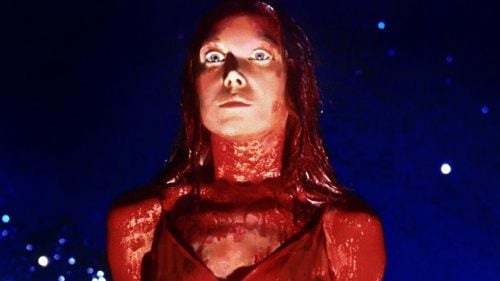In Defense Of That Scene In IT
IT is out now. Get your tickets here!
If you have a Twitter account (and you’re a Stephen King fan), you are undoubtedly going to notice a slew of new readers of his novel IT, readying themselves for the movie, expressing their horror as they reach the 1035th page mark. It’s that scene, the infamous one— an eleven-year-old Beverly offering her virginity to the rest of the Losers in an effort to bond and re-center them. In the sewer. While fighting an ancient evil. It’s a three-layered scene, all of them pretty disgusting.
How it flew so far under anyone’s radar is surprising to me, but I guess not everyone devoured every King novel when they were 12. I usually react to these tweets of disgust with a bit of humor (and yes, I admit to mocking those who ask, “Was this scene in the movie?” with derision—of course a pre-teen gang train was aired on Primetime ABC!). I was young when I read this book, and I was probably a little precocious, so it never registered to me as bizarre, perhaps because I was so close in age to the characters and could not comprehend the ickiness of the scene through an adult’s perspective. Looking back now, it does strike me as over-the-top, and, while it is not gratuitous or overly eroticized in any way, I do feel like it may be a little shoe-horned, as if King needed to throw in some sort of controversial sex and, so close to the end of the novel, panicked and chose children in the sewer as his go-to.
Still, I am in defense of this scene, and I know I am in a minority. Most reactions deem it unnecessary and insulting (and though I have been vocal about viewing older works with a modern lens, I don’t think preteen sex has ever really been an appropriate topic). I understand the necessity and importance King was striving for with this particular scene. These are children, yes, but they are neglected, abused, and otherwise ignored; they have been thrown into an early adulthood by their domineering or absentee parents— their sex act is an adult act. It is presented as mature and loving, an act of unity. They are being forced into adulthood even further by their confrontation with IT. Their childhood innocence—any shred of it that is left, anyway— is now gone completely; sex is the least of their concerns. And yes, perhaps it is in King’s wheelhouse to throw in a “magical” character, often problematic—here, it is Beverly using her femininity as a magical element, perhaps even reclaiming her power after her father so cruelly objectifies and shames her, accusing her of slutting it up with her best friends and demanding proof she is still a virgin. It may not be the most well- written scene, but I can totally buy it. It is believable to me.
When asked what he was striving for, King responded to StephenKing.com:
“I wasn't really thinking of the sexual aspect of it. The book dealt with childhood and adulthood --1958 and Grown Ups. The grown-ups don't remember their childhood. None of us remember what we did as children--we think we do, but we don't remember it as it really happened. Intuitively, the Losers knew they had to be together again. The sexual act connected childhood and adulthood. It's another version of the glass tunnel that connects the children's library and the adult library. Times have changed since I wrote that scene and there is now more sensitivity to those issues.”
IT was written in 1986, before King’s sobriety, and often when the sewer scene comes up people dismiss it as a result of some sort of alcoholic and drug induced stupor, trying their best to ignore it entirely or make an excuse for it. When I posted on Facebook that I was writing about this topic, a friend commented that she skips over this scene completely, preferring to imagine that they hug it out and go on their merry way.
When the book first appeared, The New York Times’s Christopher Lehmann-Haupf was one of the few reviewers to mention the sewer scene, albeit briefly, lumping it in as one of the many horrors happening beneath Derry’s streets. In this article from Litreactor centering around the scene, Peter Derk writes: “It’s tough to say that NO reviews from 1986 mentioned the sex scene as a problematic aspect of the book… But, swap to current times, and it’s virtually impossible to find a review that fails to mention the scene. Even if there was mention of it in 1986, it wasn’t the massive deal that it is in reviews today.” He concludes that, while off- putting, a horror novel could get away with such a controversial scene far more easily then than in 2017.
Perhaps Grady Hendrix from tor.com comes closest to framing this scene in the way I see it:
“[IT] draws a hard border between childhood and adulthood and the people on either side of that fence may as well be two separate species…Beverly is the one in the book who helps her friends go from being magical, simple children to complicated, real adults. If there’s any doubt that this is the heart of the book then check out the title. After all, “It” is what we call sex before we have it.”
Regardless of what I think, the sewer scene in IT is always going to be polarizing; there will always be the knee jerk disgust that (understandably) comes with the thought of children copulating, even if it is framed as a result of a showdown with an embodiment of ancient evil. A quick glance at the Goodreads page will show you that most people are aghast at the notion, and that it even ruins the novel for them. Sex and abuse are such delicate topics, and people process them in different ways; the idea that these are children (even in a fiction novel in which their biggest enemy is a being that shows up as a clown) is hard for a lot of people to digest. As ill-advised as the scene may be, I believe it forwards the story, and has its rightful place in the text. And whether you find this scene as sex-positive and powerful, or a regrettable choice of plot development from a man who was probably not in his right mind when he wrote it, we’re still talking about it 31 years after the fact, and that is something.



